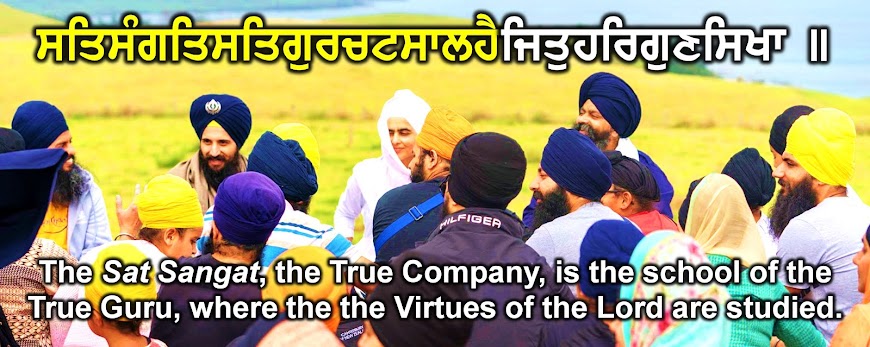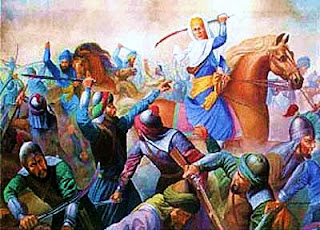Today it is the Seventh Guru, Dhan Dhan Guru Har Rai Sahib jee's prakaash diwas (birth day). Lakh Lakh Vadhaayee (many happy returns) to everyone on this Gurpurb. May Guru Sahib bless us all.
A GLIMPSE AT THE LIFE OF GURU HAR RAI SAHIB JEE
 Story of Kurta stuck on thorn flower
Story of Kurta stuck on thorn flowerAs a young child Guru Sahib was running in the flower garden at Kiratpur Sahib. He was wearing a baggy cloak (Chola). While running the cloak he brushed passed some flowers, thus the flowers were damaged. With love and compassion, Guru Hargobind Sahib jee, the seventh Guru's grandfather, explained: "Always walk and move with care. Look after and manage your cloak and ensure that it doesn't hurt or damage anything in its path." Guru Hargobind Sahib jee taught his grandson that "one should watch how one walks" and work on oneself. Guru Sahib promised his grandfather, that he would in the future be careful in his responsibilities towards man, animals and plants. Boundless compassion and charity were reflected in all his actions and dealings with others throught Guru Sahib's life.
 Protection of Animals & Environment
Protection of Animals & EnvironmentGuru Sahib founded free hospitals, herbal medical clinics, animal sanctuaries and beautiful gardens. Guru Har Rai Sahib jee developed Kiratpur sahib as a town of parks and gardens. Located on the banks of tributary of the Sutlej, he planted flowers and fruit bearing trees all over the area. This created a salubrious environment, attracting beautiful birds to the town and turning it into an idyllic place to live in. The Guru would go hunting; capturing animals he would care for them and give them treatment. When the animals were healthy and fit they would be released into the animal sanctuary or wild.
 Excommunication Directive
Excommunication DirectiveBaba Raam Rai jee, Guru Sahib's son, was sent by Guru jee to meet with Aurangzeb. In order to please the Emperor and gain his sympathy Baba Raam Rai distorted Gurbani. As a result of this Aurangzeb rewarded him with land at Dehra Doon. When Guru Sahib found out he immediately excommunicated Baba Ram Rai jee. Guru showed that no one has a right to orally or physically alter the Word of God. Once some Sikhs asked Guru Arjan Sahib jee that Gurbaani is difficult to understand and that instead can he produce a translation. Kavi Santokh Singh jee writes that Guru Sahib replied, “Even if I wanted to, I couldn’t. No one has power to limit Gurbaani.” The lesson learnt is that our relationships need to be kept checked.
 Devotion to Gurbaani
Devotion to GurbaaniOne day the Sikhs asked Guru Sahib whether those who read Gurbaani without understanding it obtain any spiritual advantage from it. Guru Sahib gave no reply at the time, and next morning went hunting. En route, the Guru came across a broken pot which had held butter. The rays of the sun were melting the butter on the broken pot fragments. Guru Sahib took one of these fragments in his hand and said, "Look my Sikhs, broken pot parts - when they are heated, the butter that adhered to them readily melts. As the grease sticks to the pot, so does the Guru’s Word stick to the heart. Whether understood or not, it has within it the "seed of salvation." Perfume still clings to a broken vase." We learn that whoseoever daily reads the Gurbaani shall surely obtain peace. And even though one may not fully understand it, Vaheguru will undoubtedly assist the person to understand.
 22,000 Horsemen
22,000 HorsemenAlthough very sensitive and caring, Guru Sahib was ever ready to fight for sovereignty and justice. Arms remind us of sovereignty. Guru Sahib exemplified that one should live a caring and compassionate life and always be ready to defend oneself and others.
SummaryBhai Nand Lal Singh jee summarises Guru Har Rai Sahib jee personality with the word "Compassion"! J. G. Cunningham describes in his book "History of Sikhs" that the Seventh Nanak lived "a life of humility" and is "the Image of Compassion".





































